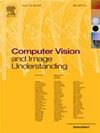稀疏深度测量融合的尽可能全局立体匹配
IF 4.3
3区 计算机科学
Q2 COMPUTER SCIENCE, ARTIFICIAL INTELLIGENCE
引用次数: 0
摘要
最近备受赞誉的AGAP (as - global - as - possible)和SDMF (Sparse Depth Measurement Fusion)方法已经成为解决立体匹配问题的著名解决方案。AGAP解决了半全局匹配(SGM)在条纹效果方面的先天缺陷,而SDMF利用主动深度传感器来提高视差计算。在本文中,这两种方法相互交织,以获得更好的视差估计。随机稀疏深度测量与基于扩散的融合融合,以更新AGAP的匹配成本。然后,基于邻居的融合进一步细化成本,利用之前的结果。最后,利用基于分割的视差细化策略对离群点和不匹配像素进行处理,得到最终的视差结果。在各种立体数据集上的性能评估表明,该算法不仅超越了其他具有挑战性的立体匹配算法,而且达到了接近实时的效率。值得指出的是,尽管没有使用任何基于学习的技术,但我们的建议在Middlebury v.3在线评估系统上出人意料地优于大多数基于深度学习的立体匹配算法,进一步验证了其优越性和实用性。本文章由计算机程序翻译,如有差异,请以英文原文为准。
As-Global-As-Possible stereo matching with Sparse Depth Measurement Fusion
The recently lauded methodologies of As-Global-As-Possible (AGAP) and Sparse Depth Measurement Fusion (SDMF) have emerged as celebrated solutions for tackling the issue of stereo matching. AGAP addresses the congenital shortcomings of Semi-Global-Matching (SGM) in terms of streaking effects, while SDMF leverages active depth sensors to boost disparity computation. In this paper, these two methods are intertwined for attaining superior disparity estimation. Random sparse Depth measurements are fused with Diffusion-Based Fusion to update AGAP’s matching costs. Then, Neighborhood-Based Fusion refines the cost further, leveraging the previous results. Ultimately, the segment-based disparity refinement strategy is utilized for handling outliers and mismatched pixels to achieve final disparity results. Performance evaluations on various stereo datasets demonstrate that the proposed algorithm not only surpasses other challenging stereo matching algorithms but also achieves near real-time efficiency. It is worth pointing out that our proposal surprisingly outperforms most of the deep learning based stereo matching algorithms on Middlebury v.3 online evaluation system, despite not utilizing any learning-based techniques, further validating its superiority and practicality.
求助全文
通过发布文献求助,成功后即可免费获取论文全文。
去求助
来源期刊

Computer Vision and Image Understanding
工程技术-工程:电子与电气
CiteScore
7.80
自引率
4.40%
发文量
112
审稿时长
79 days
期刊介绍:
The central focus of this journal is the computer analysis of pictorial information. Computer Vision and Image Understanding publishes papers covering all aspects of image analysis from the low-level, iconic processes of early vision to the high-level, symbolic processes of recognition and interpretation. A wide range of topics in the image understanding area is covered, including papers offering insights that differ from predominant views.
Research Areas Include:
• Theory
• Early vision
• Data structures and representations
• Shape
• Range
• Motion
• Matching and recognition
• Architecture and languages
• Vision systems
 求助内容:
求助内容: 应助结果提醒方式:
应助结果提醒方式:


